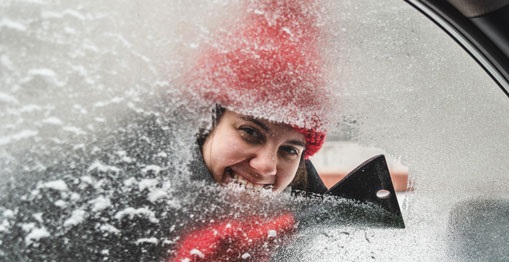

Use your vehicle's automatic climate control system on defrost. When the ice begins to melt, remove it with a plastic scraper, the windshield wipers, a rubber squeegee or a soft bristled brush.
Driving in sleet or freezing rain can be dangerous. Being prepared is your best weapon of defense!
When droplets freeze on contact with roads, wind shields and sidewalks, this can become winter’s most treacherous condition.
What is sleet and freezing rain?
Freezing rain and sleet begins as falling snow. As it passes through a layer of warmer air, the snowflakes melt and turn to rain. As the droplets fall, they pass through a layer of cold air (below 32° degrees). If it is a thin layer of cold air, then freezing rain will result as the droplets did not have enough time to freeze. If the layer of cold air is deep, the droplets freeze before hitting a surface resulting in sleet. These supercooled drops strike a cold surface, like cars and roads turning surfaces shiny and slick. Ice storms can be the most devastating and unpredictable of winter weather conditions and are often the cause of automobile accidents, power outages and personal injury.
Do not drive if you do not have to.
If you are aware of freezing rain conditions, stay home. Even with the reduction of speed, slick conditions like freezing rain just means that you will slide slower across the ice-coated roads.
Weather and road conditions can change while you are driving.
Freezing rain and sleet will quickly coat your car with a layer of ice. If freezing rain begins to fall and you must drive in it, it is best to keep your car as warm as possible so that you minimize the chance of ice forming on windows and compromise visibility.
Should sleet and freezing rain begin while you are driving, the best thing to do is to find a safe location off the highway or busy road and wait for the storm to pass. Do not pull over to the side of the road as other cars may not see you until they are close enough to hit their brakes and possibly slide into you.
Crank up your windshield defroster and make sure your wipers are ready.
Visibility tends to be the worst in icy conditions. Make sure your wipers are in the best possible condition. If they streak, skip, or leave patches you cannot see through, replace them as soon as possible.
Know where ice is most likely to form first so you can take extra caution when approaching them.
Areas like bridges and overpasses, low lying areas, areas in shadow, higher elevations, and roads near bodies of water are all the first places ice will appear. When driving through these areas, be cautious and take your time.
Contrary to popular belief, four-wheel drive vehicles do not make a difference in sleet or freezing rain.
When there is ice on the road, there is very little, if any, friction, or resistance to keep the tires where you want them. Ice does not care whether you are a good driver, have the best tires, or drive the most winterized vehicle ever to hit the road. The best defense for ice is to stay off the road.
Stay alert – it can save your life.
Driving in freezing rain demands the utmost concentration. Drive with limited distractions and focus on the road and those around you.
Driving in sleet or freezing rain is obviously dangerous but being prepared is your best weapon of defense! Live assured with these tips and with Preferred Mutual!
This information is intended for educational purposes only and is not legal advice and/or an authoritative guide.